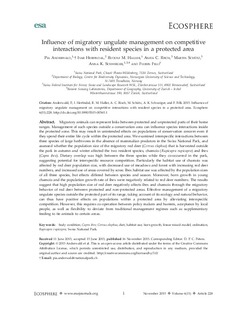| dc.contributor.author | Anderwald, Pia | |
| dc.contributor.author | Herfindal, Ivar | |
| dc.contributor.author | Haller, Rudolf | |
| dc.contributor.author | Risch, Anita C. | |
| dc.contributor.author | Schütz, Martin | |
| dc.contributor.author | Schweiger, Anna K. | |
| dc.contributor.author | Filli, Flurin | |
| dc.date.accessioned | 2018-01-02T11:26:37Z | |
| dc.date.available | 2018-01-02T11:26:37Z | |
| dc.date.created | 2016-01-13T19:30:49Z | |
| dc.date.issued | 2015 | |
| dc.identifier.issn | 2150-8925 | |
| dc.identifier.uri | http://hdl.handle.net/11250/2473991 | |
| dc.description.abstract | Migratory animals can represent links between protected and unprotected parts of their home ranges. Management of such species outside a conservation area can influence species interactions inside the protected zone. This may result in unintended effects on populations of conservation concern even if they spend their entire life cycle within the protected area. We examined interspecific interactions between three species of large herbivores in the absence of mammalian predators in the Swiss National Park, and assessed whether the population size of the migratory red deer (Cervus elaphus) that is harvested outside the park in autumn and winter affected the two resident species, chamois (Rupicapra rupicapra) and ibex (Capra ibex). Dietary overlap was high between the three species while they co-occurred in the park, suggesting potential for interspecific resource competition. Particularly the habitat use of chamois was affected by red deer population size, with decreased use of meadows and forest with increasing red deer numbers, and increased use of areas covered by scree. Ibex habitat use was affected by the population sizes of all three species, but effects differed between species and season. Moreover, horn growth in young chamois and the population growth rate of ibex were negatively related to red deer numbers. The results suggest that high population size of red deer negatively affects ibex and chamois through the migratory behavior of red deer between protected and non-protected areas. Effective management of a migratory ungulate species outside the protected part of its range, taking account of its ecology and natural behavior, can thus have positive effects on populations within a protected area by alleviating interspecific competition. However, this requires co-operation between policy makers and hunters, acceptance by local people, as well as flexibility to deviate from traditional management regimes such as supplementary feeding to tie animals to certain areas. | nb_NO |
| dc.language.iso | eng | nb_NO |
| dc.publisher | Ecological Society of America | nb_NO |
| dc.rights | Navngivelse 4.0 Internasjonal | * |
| dc.rights.uri | http://creativecommons.org/licenses/by/4.0/deed.no | * |
| dc.title | Influence of migratory ungulate management on competitive interactions with resident species in a protected area | nb_NO |
| dc.type | Journal article | nb_NO |
| dc.type | Peer reviewed | nb_NO |
| dc.description.version | publishedVersion | nb_NO |
| dc.source.volume | 6 | nb_NO |
| dc.source.journal | Ecosphere | nb_NO |
| dc.source.issue | 11:228 | nb_NO |
| dc.identifier.doi | 10.1890/ES15-00365.1 | |
| dc.identifier.cristin | 1312556 | |
| dc.relation.project | Norges forskningsråd: 223257 | nb_NO |
| dc.description.localcode | © 2015 Anderwald et al. This is an open-access article distributed under the terms of the Creative Commons Attribution License, which permits unrestricted use, distribution, and reproduction in any medium, provided the original author and source are credited. http://creativecommons.org/licenses/by/3.0/ | nb_NO |
| cristin.unitcode | 194,66,10,0 | |
| cristin.unitname | Institutt for biologi | |
| cristin.ispublished | true | |
| cristin.fulltext | original | |
| cristin.qualitycode | 1 | |

